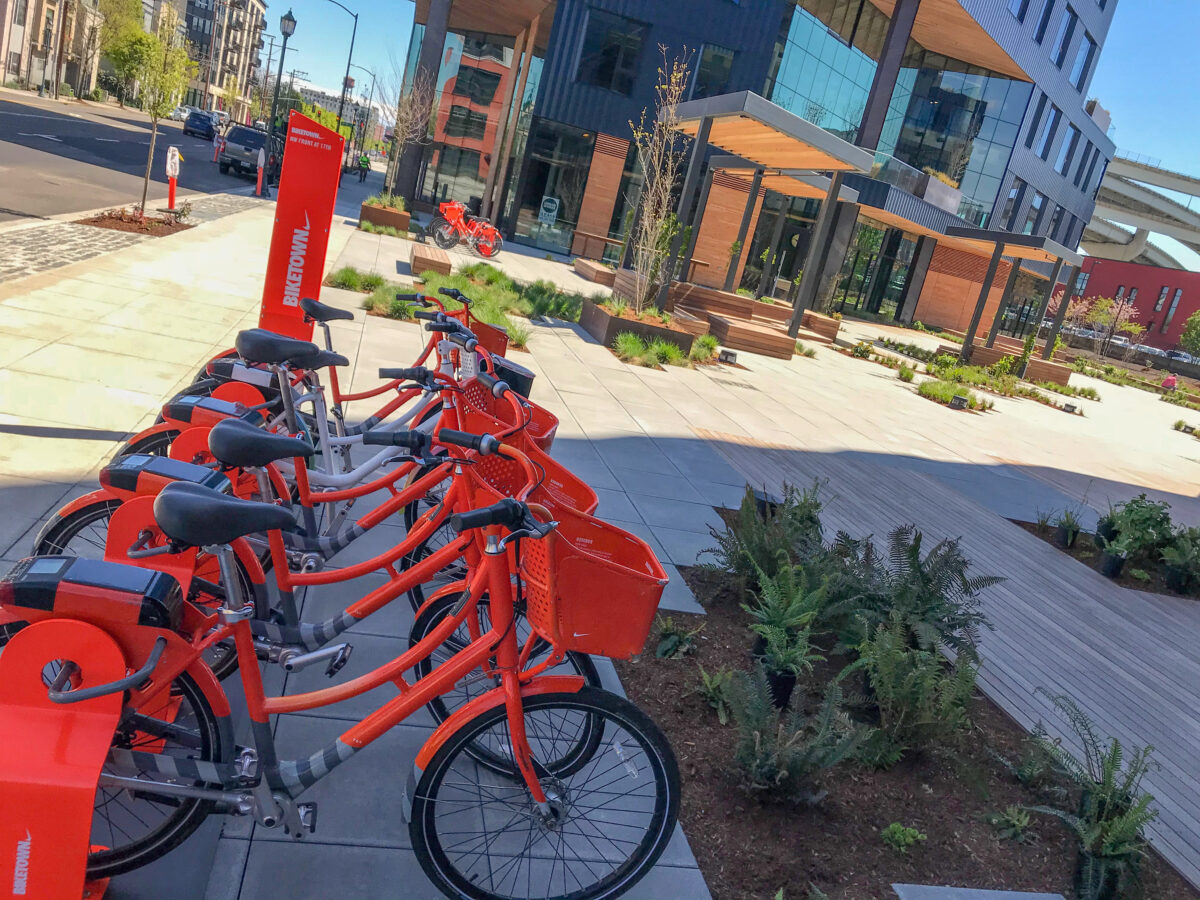
(Photos © Jonathan Maus)
It’s usually a good sign when the private sector invests in a city-run transportation program. Such is the case with the new Biketown station at the new Field Office in northwest Portland.
Believing that access to bike share is an asset for their tenants and neighbors, the developers of a pair of new office buildings on NW Front/Naito between 15th and 17th have ponied up for a station and 15 bikes.
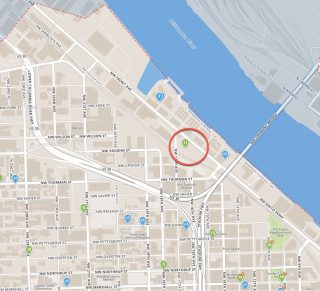
Jonathan Ledesma, a partner at the real estate firm behind the Field Office project said in a statement, “We’re thrilled to be part of Biketown’s growth and hopeful other property owners and businesses will see the benefits in sponsoring a station.”
PBOT says the price tag for the sponsorship is $29,000 (Portland’s bike share contract lists the cost of a bikes at $1,600 each, and kiosks cost $9,500). Of the 15 bikes, Field Office is covering the cost of 10 of them and the other five will come from the existing Biketown fleet. In addition to equipment costs, Biketown operator Motivate Inc. charges the city $187 per bike in operation costs.
The new station (which is part of the public system and can be used by any Biketown user) fills a void in Biketown’s service area. As you can see in the map, before Field Office stepped up there was no station in the fast-growing area now known as the Frontside District along the Willamette River north of the Fremont Bridge and east of Highway 30.
PBOT Director Leah Treat says the private sponsorship is a sign that Biketown has been integrated into the city’s transportation system. “Combined with the record breaking ridership numbers we’ve seen this month, [this sponsorship] affirms the importance of Biketown for Portland businesses and residents alike.
Advertisement
Field Office tenants include computer and software related firms, as well as a childhood education business. The two-building campus has 300,000 square feet of office and retail space connected via a plaza space that mixes natural and industrial elements. It’s just one of several new developments in this district that’s quickly changing from a relatively forgotten, industrial area to a bustling community for residents and workers alike.
Two years ago we profiled the vast potential for biking in this area as projects like Field Office come online. In January 2017 we reported that the firm behind Field Office would put $1.1 million toward a $2.6 million street update project. The project was initially slated to repave and restripe NW Front, upgrade traffic signals and intersection treatments at NW 9th, 15th, and 17th, and add buffered bike lanes to close the gap that currently exists between NW 9th and 15th.
Architect and NextPortland.com publisher Iain MacKenzie says PBOT has since upgraded their plans to include protected bike lanes, floating bus islands, a protected left turn onto NW 9th (to access the Pearl District), and median islands to improve crossing safety.
These upcoming improvements to Front/Naito (construction of which should start this summer) will connect to other recent bikeway upgrades near the Steel Bridge and along Waterfront Park. Once we make Better Naito permanent, we’ll have protected or buffered bike lanes for the entire 2.5 mile stretch between NW 17th and SW Harrison.
UPDATE/CORRECTION, 6/1: This story has been updated to reflect new numbers for the cost of the sponsorship. I estimated the cost would be $35,000, but PBOT says it totals $29,000.
— Jonathan Maus: (503) 706-8804, @jonathan_maus on Twitter and jonathan@bikeportland.org
Never miss a story. Sign-up for the daily BP Headlines email.
BikePortland needs your support.


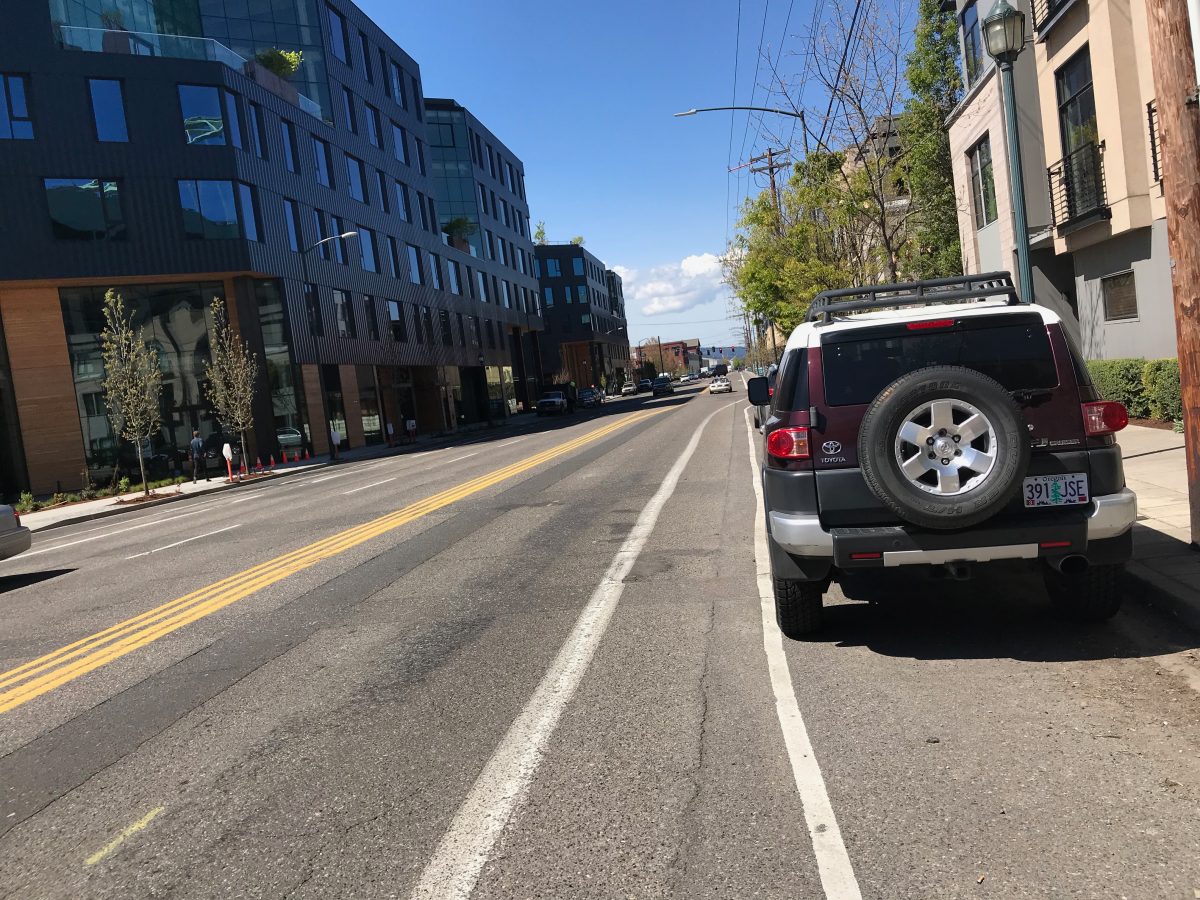
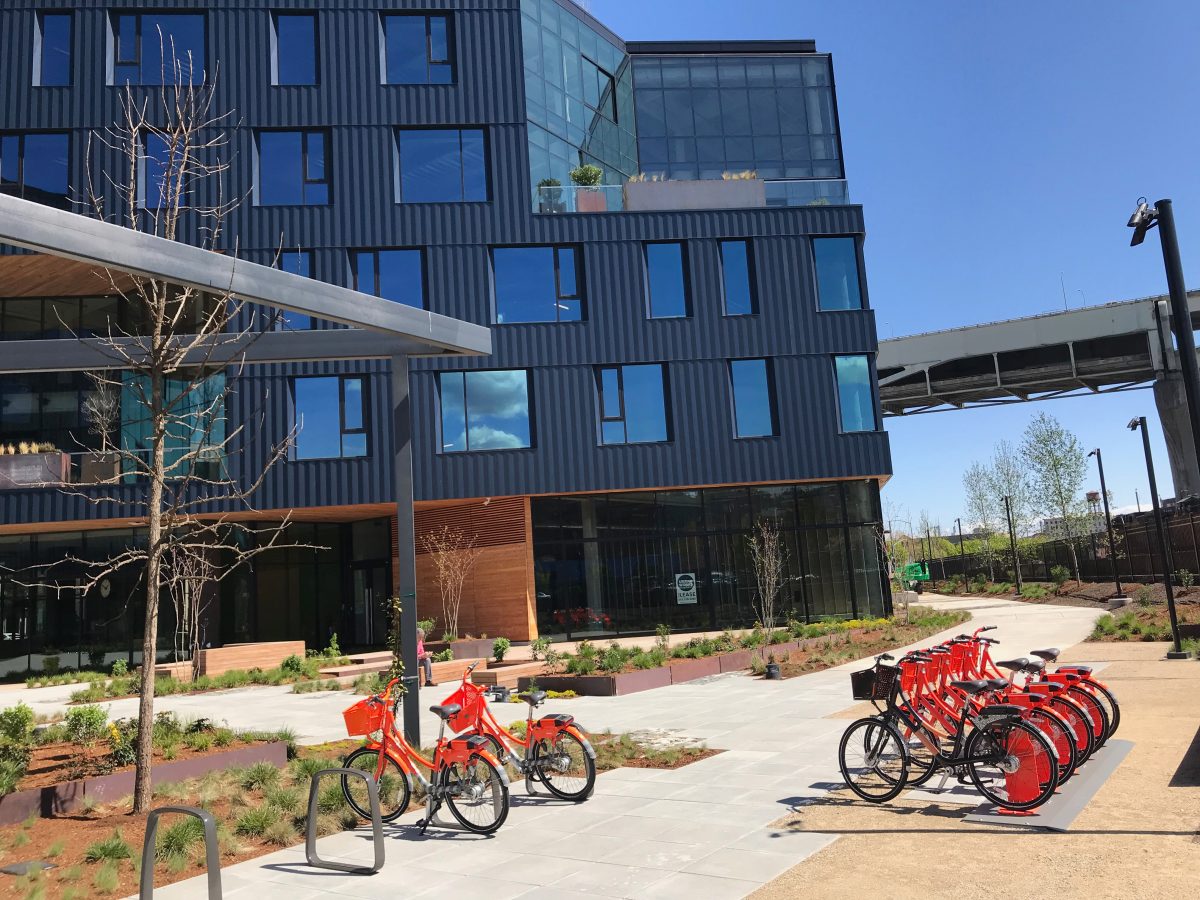
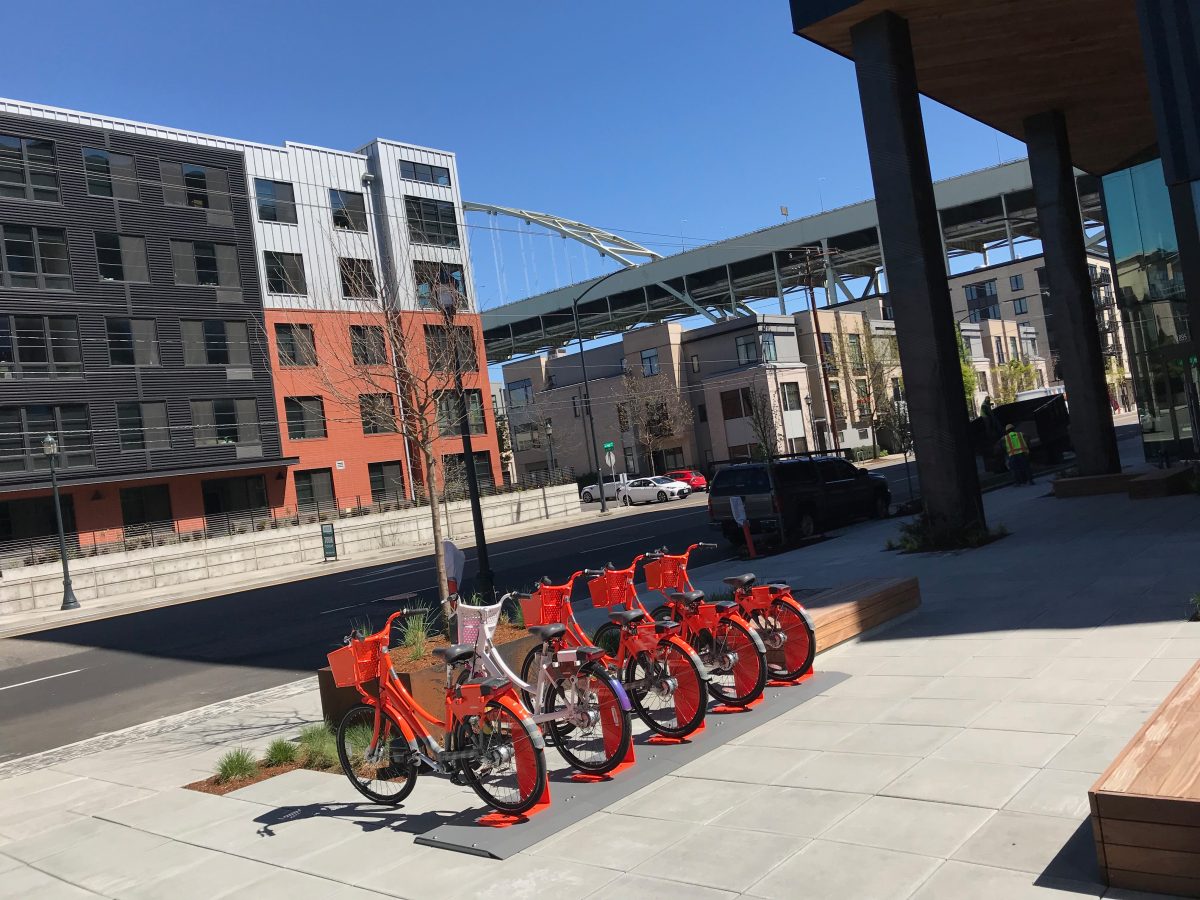
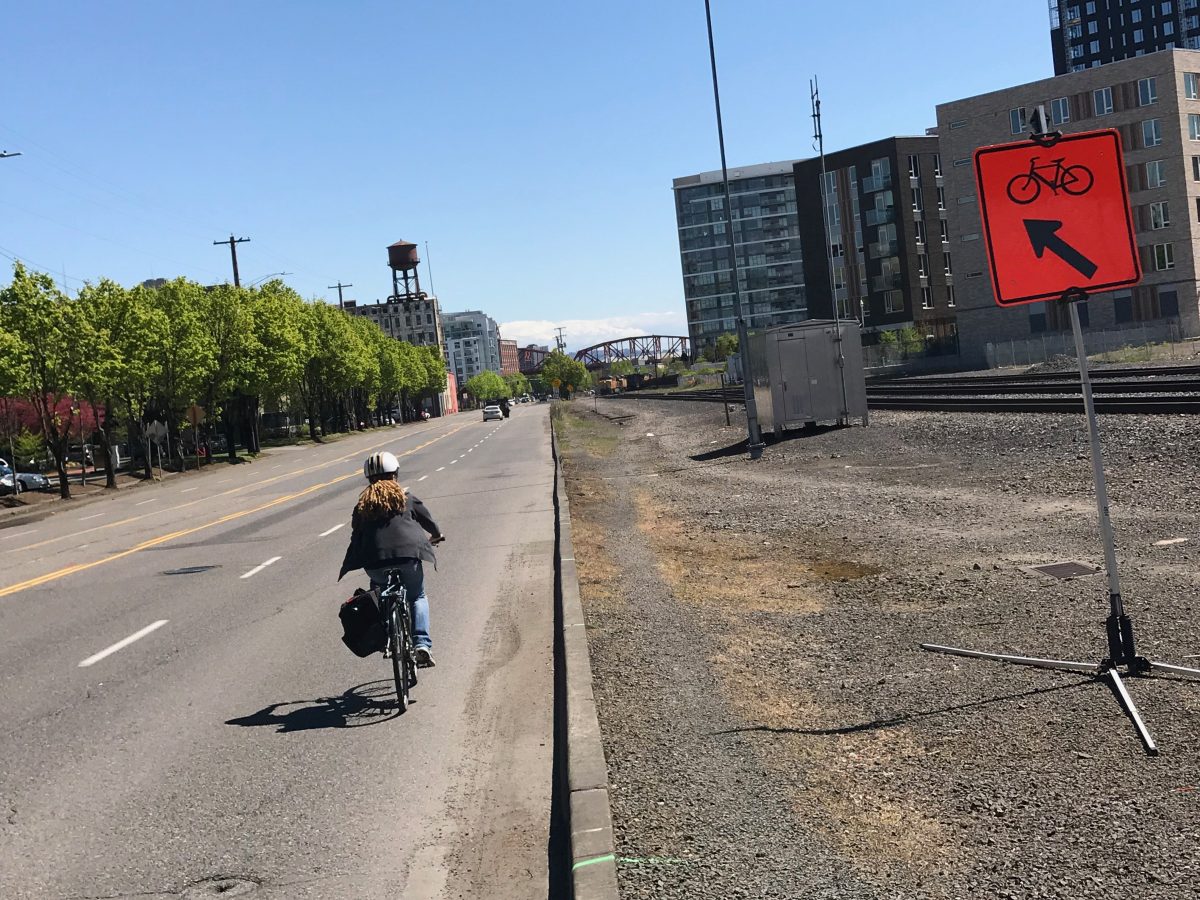
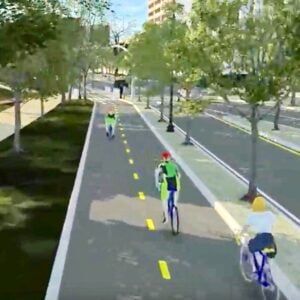
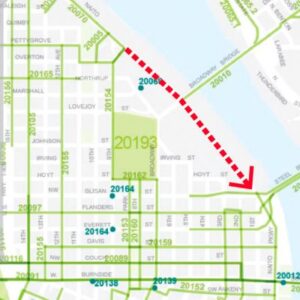
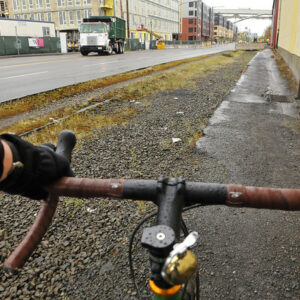
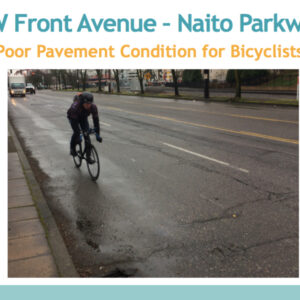
Thanks for reading.
BikePortland has served this community with independent community journalism since 2005. We rely on subscriptions from readers like you to survive. Your financial support is vital in keeping this valuable resource alive and well.
Please subscribe today to strengthen and expand our work.
Good to see these types of services being provided. Would be very nice if businesses doing such things would help push out the borders of the service area.
Wanted to make sure I’m interpreting the statistics properly. Does that $184/bike mean that each bike costs on average $6/day to operate (I’m assuming that includes all maintenance/rebalancing/replacement/etc)?
Also, do you have a sense of e-bike share operational costs?
those numbers are just ridiculous. Right now use barely covers the maintenance.
How are those bikes $1600 each?
Shaft drive, fancy basket, custom paint job, electronics. The tires alone run about $130 retail.
Hub brakes, generator, integrated lighting in addition to shaft drive and GPS/computer/solar panel, and the components are heavy duty. These are not inexpensive bikes. Add the specialized nature of the bike. $1,600 is not surprising.
Integrated lighting alone is preposterously expensive in the United States.
People used to biking might be fine in the dark, but people coming from cars have different expectations.
I’ve had dynamo lighting for ages and thought halogen was fine but until even LED tech wasn’t enough for my partner, who may at this point simply be tolerating it instead of dealing with the range anxiety and security issues of non-fixed battery lights.
Agree, but the bikes have to be super sturdy (and therefore clunky) because 1) humans are often stupid, and 2) file lawsuits. They are probably produced via a custom contract, and if sold in a shop would never be able to sell for more than $300. In fact I’m not sure why anyone would purchase for personal use at any price. The GPS and related equipment also adds cost.
Also, most bike share system bikes use non-standard sized components so that it becomes pointless to steal bikes, or their components. For example, the wheels won’t fit on a retail bike, so no one is going around stealing the wheels.
Guess they didn’t get the memo about the upcoming LimeBike / Spin rollouts. Ouch!
Just wondering when my first comment will be approved. Or is it being censored by Jonathan for speculating that Lime / etc will soon overtake BIKETOWN? I guess I’m not surprised by the bias.
Hi Maxadders,
I approved your comment just now. You left it 45 minutes ago and I was in the middle of writing another post. Also, I find your comment about censorship totally off-base and completely without merit. Do you really think I would hold back a comment for that reason? Come on. Maybe you missed the stories here on BP where I’ve covered the oncoming onslaught of dockless bikes/scooters from Lime?
There’s a reason you are automatically moderated. If you would like your comments to appear immediately, you should be more sensitive about taking personal jabs at others and/or making unsubstantiated allegations of bias. Thanks.
Does the “reason” my posts are sent to moderation have anything to do with the fact that I occasionally disagree with you? What if I signed up for a monthly subscription, would my opinions be valid then?
I don’t recall the reason but I can guarantee you it has nothing to do with disagreeing with me. And you know the answer to your second question so I won’t even answer it. Thanks.
This might be a good time for self-reflection regarding your approach to life and relationships. Think of this auto-moderation as your intervention. You can get through this, man.
I love this. JM is an inexpensive therapist for those of us who tend to stray out into Rudeland.
I appreciate it when my posts get moderated because it either means I’ve used some word or phrase that is best left untyped or that I’ve been spending too much time in Rudeland and have made the auto-mod list for a brief time-out.
I think the concept is solid.
I would prefer if the content of the posts were replaced with the reason the action was necessary as has sometimes been done in the past.
This would address the immediate issue, call out the offender, and make the process more transparent while serving as a useful reminder to all and maybe even prevent unintentional future offenders.
I don’t know if this would introduce too much administrative overhead to be practical.
WTF – $2,760 per month in additional operation fees ($184 per bike)
is it just me or is that way high…just wow…15 bikes cost almost 3 time my mortgage payment…
just wow..
hey i got a few bike I will gladly rent out a few bikes for that price per month…
This is my one of my ongoing questions as well. Bikes are cheap. $50 a $150 can get you most anything decent on Craigslist. For a fraction of the listed costs above they could buy regular (used) bikes and the equipment to make them complete, useful, and , while they are at it, plow the money back into the local economy ( for the bikes, the parts, the labor to assemble them, etc). With the orange ones my sense ( I could be wrong) is that most of the money quickly leaves our town and never returns.
Maintenance on a non-standardized fleet would be a nightmare. The maintenance crew would all need to be highly proficient in repairing all kinds of bikes. Meanwhile, unless you only purchased a very specific make of bike, users would have no idea if the bikes they were about to ride would even fit them. A lot of modifications would need to be made to the bikes as well, such as installing easy-adjust seats and adding baskets. Bike share bikes across the world look and ride very similarly for a reason: yes they’re heavy and slow, but pretty much anyone who learned to ride a bike when they were 8 can ride an upright, step-through bike (not true for diamond frames and low handlebars. The heavy, upright nature of the bikes is considered a contributing factor in bike share’s good safety record.
Sure. I get all of that. And the entity in question clearly has and can justify the expense. I just view the world through very different eyes.
Putting a $50 bike off Craigslist on the street as a bikeshare bike basically means donating that bike to anyone wanting a free bike. No integrated lock, no GPS for users to locate the bike, no way to charge for the ride, standard bike wheels and other parts for tweakers to take, etc. You’re repeating the Yellow Bike experiment which was a total failure.
That wasn’t actually what I was suggesting, though I see i could have been clearer. I meant they could just buy bikes for their constituents (if they are determined to spend money in this manner). When you dig into the details the economic model of bikeshare always looks a little odd to me when compared to what I know.
Simply buying bikes won’t help.
The reason people drive cars isn’t because they lack access to cheap bikes.
Oh really?
Then why are we/is Nike buying expensive bikes and painting them orange then?
If it’s because they think people won’t cut their transportation costs by 90% with the initial investment paying for itself in the first month because they need financial assistance, they didn’t think it through very well.
I believe your plan suffers from the same flaw.
What if I want to ride one-way and meet a friend to drive somewhere? What if I want to ride one-way and take MAX for the return? What if I don’t want to lock up a personal bike in a bad neighborhood? There are so many potential uses for bikeshare that a cheap Craigslist bike does not satisfy. It’s why these programs are very popular.
Yes. I have my own bike, and use Biketown regularly for reasons similar to the ones you describe. Giving people bikes, no matter how cheaply, doesn’t solve the mobility problems that bike share can.
There’s a similar train of thought in response to bikeshare proponents promoting it as a tool for improving access to bikes for people that can’t afford them, and worthy of public subsidy on those grounds. If that’s your goal, simply buying bikes for people would be a better-targeted subsidy. Example: Adonia Lugo.
I suspect that one of the major reasons bike shops don’t do this sort of business is that so many of the bikes peddled on CL are stolen. Even legit owners typically don’t have the paperwork to prove it. Businesses don’t want to become known for selling stolen goods.
So legit bike shops that deal in used bikes are going to have requirements many sellers can’t meet. That’s probably part of the premium you pay for buying used bikes at proper shops compared to Craigslist (i.e. a premium for scarcity of provably legitimate used bikes). And they’re not going to run all over town following Craigslist ads for sellers that may not have proper documentation, they’re going to make the sellers come to them.
The cost is in labor — it takes a lot of work to keep the service going. Systems, facilities, and administration (management/financial/maintenance/legal/insurance/compliance/etc) costs will also be significant.
For example, something that sounds as simple as fixing a tube requires procurement and accounting mechanisms. Don’t forget you have to pay someone to install it which has its own nontrivial HR overhead (in addition to OPE) after you pay a modest salary which by itself will not look that cheap for the job.
Just putting cheap bikes out there will result in unusable junk all over the place.
I can’t use Biketown because of the service area, but I think it is a very good thing and they do a good job.
I wouldn’t be surprised if a lot of it is for the labor of daily “rebalancing” – moving bikes from full to empty stations. It’s usually done by truck (which has its own operating expenses) with two people (who are not volunteers) working together as a team. I’m not sure how many teams are out there daily, but the costs here add up quickly. The second biggest expense is probably maintenance, and given the propritary nature of the components, they are unlikely to also be cheap or easy to work on. Don’t forget bureaucratic overhead too, which pretty much doubles the cost of anything and boom, $184/month/bike almost seems reasonable.
It would be lovely if Biketown was transparent with their costs of operation. I guess there must be downsides that exceed the upside of satisfying our curiosity, but they are thus cut off from receiving any worthwhile input from the community.
That would be interesting, but producing that data and the communications overhead inevitably resulting from questions/concerns/complaints is a significant additional cost.
One thing I found amusing when I worked for the state was that we were required by law to collect and produce all kinds of data to be transparent and then everyone would whine because we were bureaucratic.
I promise we didn’t want to keep all that junk and spend time servicing requests from every kook who feels obligated to second guess and micromanage processes they know absolutely nothing about, but that the price of transparency and democracy. On an aside note, I always found it puzzling that people are always paranoid about the government they helped elect and can vote out rather than companies that give them neither info nor recourse.
The NW Naito / Front LID is now out to bid. The full plans are available to view here:
https://procure.portlandoregon.gov/bso/external/bidDetail.sdo?bidId=00000944&parentUrl=activeBids
Thanks for the link. These plans will drastically improve multimodal access and connectivity in this area, and deserve their own post, instead of being buried here.
Wow, that’s the best design I’ve ever seen out of PBoT. The parking along the curb plus the buffer on Front is a full eleven feet, which almost takes in the entire door zone so that under the worst of conditions there are still five feet of bike lane clear of the door zone.
I’m still not a fan of so-called “protected” bike lanes because they make intersections, the most troublesome place, more dangerous. I guess being able to roll one direction without a bad implementation is about as good as it’s going to get.
This would be a great replacement for parking requirements. I know the city tossed those out the window, but what if X number of sponsored Biketown bikes were required per unit?
Except bike town could dry up and blow away; Nike could decide they no longer are getting enough branding out of it, etc.
Yeah, the longevity of the program is questionable as are the ethics of supporting the brand. I suppose the idea is more of an ideal than a realistic proposal based on what we really have. I think it would be dreamy to replace mandatory parking with mandatory bicycles..
Now that Biketown is going dockless, isn’t there less incentive for a building to pay for a dock?
“Giving people bikes, no matter how cheaply, doesn’t solve the mobility problems that bike share can.”
That is an interesting hypothesis. I am not sure I agree but would like to hear you flesh this out a bit.
Put another way, assuming there is a constituency who will avail themselves of bikeshare bikes, is that enough of a reason to pursue it, make it happen? I suspect we could come up with constituencies for all sorts of products, bureaucratic solutions—hover board share, those digital reader boards on Metro area freeways—but who decides that we should put the state on the case, shill to get corporate sponsors of these public-private ventures?
Was intended to be a reply to maccoinich
https://bikeportland.org/2018/05/31/portland-developer-opens-first-privately-sponsored-biketown-station-282423#comment-6909683
In Budapest (my former home), the public bike-share company Bubi offered a similar deal to private developers. I blogged about the first taker, which was a mixed-use complex in the heart of the city, pretty similar to Field Office. The developer put up the capital costs, about $25,000 for a station twice as large (30 parking spaces and maybe 20 bikes). The operator — a city-owned company — covered operational costs thereafter.
Anyway, I also thought it was a very positive sign. The bike-share in Budapest survives by a public subsidy of about half of operation costs, with the remainder coming mainly from a sponsorship contract and just a little from user fees. So the input from other private support was very welcome.
This was the post: http://cyclingsolution.blogspot.com/2015/07/bike-sharing-boosts-property-value.html